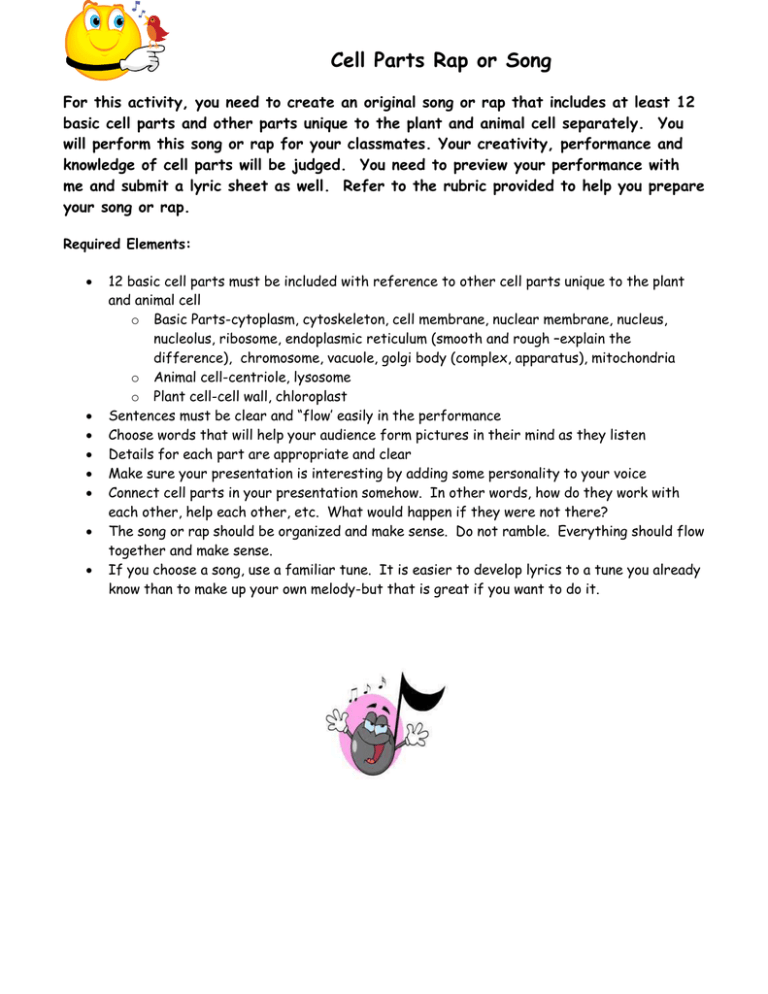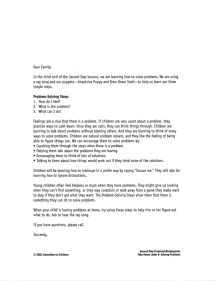Cell Parts Rap or Song
advertisement

Cell Parts Rap or Song For this activity, you need to create an original song or rap that includes at least 12 basic cell parts and other parts unique to the plant and animal cell separately. You will perform this song or rap for your classmates. Your creativity, performance and knowledge of cell parts will be judged. You need to preview your performance with me and submit a lyric sheet as well. Refer to the rubric provided to help you prepare your song or rap. Required Elements: 12 basic cell parts must be included with reference to other cell parts unique to the plant and animal cell o Basic Parts-cytoplasm, cytoskeleton, cell membrane, nuclear membrane, nucleus, nucleolus, ribosome, endoplasmic reticulum (smooth and rough –explain the difference), chromosome, vacuole, golgi body (complex, apparatus), mitochondria o Animal cell-centriole, lysosome o Plant cell-cell wall, chloroplast Sentences must be clear and “flow’ easily in the performance Choose words that will help your audience form pictures in their mind as they listen Details for each part are appropriate and clear Make sure your presentation is interesting by adding some personality to your voice Connect cell parts in your presentation somehow. In other words, how do they work with each other, help each other, etc. What would happen if they were not there? The song or rap should be organized and make sense. Do not ramble. Everything should flow together and make sense. If you choose a song, use a familiar tune. It is easier to develop lyrics to a tune you already know than to make up your own melody-but that is great if you want to do it. Cell Parts Rap/Song Rubric CATEGORY 10 8 6 4 Flow & Rhythm (Sentence Fluency) All sentences sound natural and are easyon-the-ear when sung aloud. Each sentence is clear and has an obvious emphasis. Almost all sentences sound natural and are easy-on-the-ear when sung aloud, but 1 or 2 are stiff and awkward or difficult to understand. Most sentences sound natural and are easyon-the-ear when sung aloud, but several are stiff and awkward or are difficult to understand. The sentences are difficult to sing aloud because they sound awkward, are distractingly repetitive, or difficult to understand. Word Choice Writer uses vivid words and phrases that draw pictures in the reader's mind, and the choice and placement of the words seems accurate, natural and not forced. Writer uses vivid words and phrases that draw pictures in the reader's mind, but occasionally the words are used inaccurately or seem overdone. Writer uses words that communicate clearly, but the writing lacks variety, punch or flair. Writer uses a limited vocabulary that does not communicate strongly or capture the reader's interest. Jargon or clichés may be present and detract from the meaning. Focus on Topic (Content) There is one clear, well-focused topic. At least 10 cell parts stand out and are supported by detailed information. 8-9 cell parts are clear but the supporting information is general. 6-7 cell parts are clear but there is a need for more supporting information. The main ideas are not clear. There is a seemingly random collection of information. Adding Personality (Voice) The writer seems to be writing from knowledge or experience. The author has taken the ideas and made them "his own." The writer seems to be drawing on knowledge or experience, but there is some lack of ownership of the topic. The writer relates some of his own knowledge or experience, but it adds nothing to the discussion of the topic. The writer has not tried to transform the information in a personal way. The ideas and the way they are expressed seem to belong to someone else. Transitions A variety of (Organization) thoughtful transitions are used. They clearly show how ideas are connected. Transitions clearly show how ideas are connected, but there is little variety. Some transitions work well; but connections between other ideas are fuzzy. The transitions between ideas are unclear or nonexistent. Sequencing Details are placed in (Organization) a logical order and the way they are presented effectively keeps the interest of the reader. Details are placed in a logical order, but the way in which they are presented/introduced sometimes makes the writing less interesting. Some details are not in a logical or expected order, and this distracts the reader. Many details are not in a logical or expected order. There is little sense that the writing is organized.


